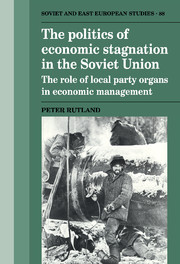 The Politics of Economic Stagnation in the Soviet Union
The Politics of Economic Stagnation in the Soviet Union Book contents
- Frontmatter
- Contents
- List of tables
- Preface
- Glossary of Russian terms and abbreviation
- Introduction: The party in the post-totalitarian system
- 1 The party and the economy: structures and principles
- 2 Party interventions in industry
- 3 Interventions in industry: case studies
- 4 The party as regional coordinator
- 5 Regional coordination: case studies
- 6 The party as fireman: party interventions in the transport and energy sectors
- 7 The role of the party in agriculture
- 8 Non-party control organs
- 9 The principles underlying the party's work with cadres
- 10 The obkom elite in the 1980s
- 11 Party and economy under perestroika
- Conclusion Party and economy in the USSR: from stagnation to collapse
- Appendices
- Notes
- Bibliography
- Index
- THE POLITICS OF ECONOMIC STAGNATION IN THE SOVIET UNION
- Frontmatter
- Contents
- List of tables
- Preface
- Glossary of Russian terms and abbreviation
- Introduction: The party in the post-totalitarian system
- 1 The party and the economy: structures and principles
- 2 Party interventions in industry
- 3 Interventions in industry: case studies
- 4 The party as regional coordinator
- 5 Regional coordination: case studies
- 6 The party as fireman: party interventions in the transport and energy sectors
- 7 The role of the party in agriculture
- 8 Non-party control organs
- 9 The principles underlying the party's work with cadres
- 10 The obkom elite in the 1980s
- 11 Party and economy under perestroika
- Conclusion Party and economy in the USSR: from stagnation to collapse
- Appendices
- Notes
- Bibliography
- Index
- THE POLITICS OF ECONOMIC STAGNATION IN THE SOVIET UNION
Summary
For the past thirty years the key debate in Western Sovietology was over the scope for economic reform in the USSR. Economists discussed whether it was possible to introduce market forces into the command economy without unleashing full-blooded capitalism. Political scientists argued over whether a determined reform-minded leader such as Gorbachev would be able to overcome the political opposition to change.
The present author is convinced that the answer to both these questions is no. The command economy represented an integral system, which functioned according to its own political and economic logic. The scope for reform in such a system – particularly economic reform – was very narrow.
Stalin put in place a set of party and ministerial bureaucracies which were able to ensure political stability while creating an industrial economy capable of taking on the Nazi war machine. However, by the 1950s and 1960s the limitations of the Stalinist model were plain for all to see. Reflecting on the disastrous experimentation of the Khrushchev years, the Brezhnev leadership realised how limited was its room for manoeuvre. The priority of the Soviet ruling elite in the 1960s and 1970s was stability and the preservation of the status quo, and they struggled to prevent social change from breaking out of the straight-jacket of existing political and economic institutions.
The price of political stability was social and economic stagnation. Twenty years of this approach brought the Soviet Union, a state richly endowed in human talent and natural resources, to the brink of economic collapse and civil war.
- Type
- Chapter
- Information
- The Politics of Economic Stagnation in the Soviet UnionThe Role of Local Party Organs in Economic Management, pp. xi - xiiiPublisher: Cambridge University PressPrint publication year: 1992
